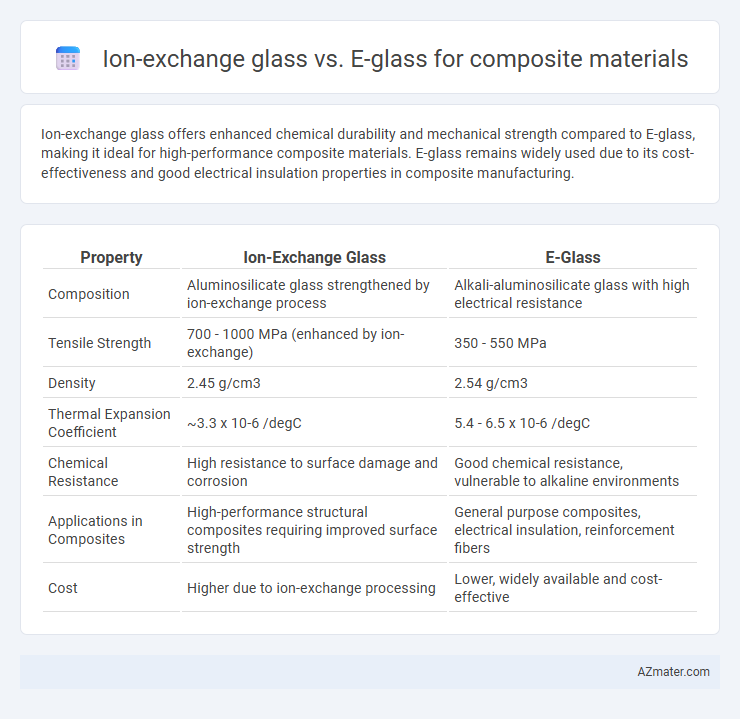Ion-exchange glass offers enhanced chemical durability and mechanical strength compared to E-glass, making it ideal for high-performance composite materials. E-glass remains widely used due to its cost-effectiveness and good electrical insulation properties in composite manufacturing.
Table of Comparison
| Property | Ion-Exchange Glass | E-Glass |
|---|---|---|
| Composition | Aluminosilicate glass strengthened by ion-exchange process | Alkali-aluminosilicate glass with high electrical resistance |
| Tensile Strength | 700 - 1000 MPa (enhanced by ion-exchange) | 350 - 550 MPa |
| Density | 2.45 g/cm3 | 2.54 g/cm3 |
| Thermal Expansion Coefficient | ~3.3 x 10-6 /degC | 5.4 - 6.5 x 10-6 /degC |
| Chemical Resistance | High resistance to surface damage and corrosion | Good chemical resistance, vulnerable to alkaline environments |
| Applications in Composites | High-performance structural composites requiring improved surface strength | General purpose composites, electrical insulation, reinforcement fibers |
| Cost | Higher due to ion-exchange processing | Lower, widely available and cost-effective |
Introduction to Composite Materials
Composite materials consist of two or more distinct constituents combined to achieve enhanced mechanical properties, with glass fibers commonly used as reinforcements. Ion-exchange glass fibers offer superior chemical durability and surface strength compared to traditional E-glass fibers, improving composite toughness and resistance to environmental degradation. E-glass remains widely used due to its cost-effectiveness, balanced mechanical properties, and ease of processing in applications requiring moderate performance.
Overview of Ion-Exchange Glass
Ion-exchange glass is engineered through a chemical strengthening process that replaces smaller ions in the glass surface with larger ones, enhancing its mechanical strength and scratch resistance. This type of glass offers superior durability and improved fracture toughness compared to traditional E-glass, making it valuable in high-performance composite applications. Ion-exchange glass's enhanced surface properties contribute to longer service life and greater resistance to environmental degradation in composite materials.
Understanding E-Glass Properties
E-glass offers high tensile strength, excellent electrical insulation, and good chemical resistance, making it a preferred reinforcement in composite materials. Ion-exchange glasses enhance surface strength through ion substitution but generally lack E-glass's versatility and cost-effectiveness in composites. Understanding E-glass properties such as its thermal stability and toughness is crucial for optimizing composite performance in automotive, aerospace, and construction applications.
Mechanical Strength Comparison
Ion-exchange glass exhibits superior mechanical strength compared to E-glass due to its enhanced surface compressive stress achieved through the ion-exchange process, which increases resistance to micro-cracks and fracture. This improvement results in higher tensile strength, improved toughness, and greater durability in composite materials. Consequently, composites reinforced with ion-exchange glass fibers demonstrate increased load-bearing capacity and extended service life compared to those using conventional E-glass fibers.
Chemical Durability and Corrosion Resistance
Ion-exchange glass exhibits superior chemical durability and corrosion resistance compared to E-glass due to its surface compressive stress layer formed during the ion-exchange process, which significantly reduces ion mobility and enhances resistance to chemical attacks in composite materials. E-glass, while cost-effective and widely used in composite applications, is more susceptible to alkaline corrosion and hydrolytic attack, resulting in lower long-term chemical stability. The enhanced corrosion resistance of ion-exchange glass makes it particularly suitable for composite materials exposed to harsh chemical environments and moisture.
Thermal Performance Analysis
Ion-exchange glass exhibits superior thermal performance compared to E-glass in composite materials due to its enhanced thermal stability and higher softening point, typically around 670degC versus 600degC for E-glass. The ion-exchange process strengthens the glass surface by replacing smaller ions with larger ones, resulting in improved resistance to thermal shock and reduced thermal expansion coefficients. This makes ion-exchange glass composites ideal for applications requiring rigorous thermal cycling and enhanced durability under elevated temperatures.
Electrical Insulation Capabilities
Ion-exchange glass offers superior electrical insulation capabilities compared to E-glass due to its enhanced chemical durability and reduced ionic conductivity. The ion-exchange process strengthens the glass surface, minimizing dielectric losses and increasing resistance to electrical breakdown in composite materials. This makes ion-exchange glass an ideal choice for high-voltage insulation applications where electrical performance and long-term reliability are critical.
Cost and Manufacturing Considerations
Ion-exchange glass offers enhanced mechanical strength due to its surface compression, making it suitable for high-performance composites but typically incurs higher raw material and processing costs compared to E-glass. E-glass remains the industry standard for composite reinforcement because of its lower cost, ease of manufacturing, and widespread availability, which supports large-scale production and cost-efficiency. Manufacturing with ion-exchange glass demands specialized heat treatment processes that can increase production time and expenses, whereas E-glass fabrication is well-established with streamlined, cost-effective workflows.
Typical Applications in Industry
Ion-exchange glass is predominantly used in high-performance optical and electronic components within the aerospace and telecommunications industries due to its superior surface strength and chemical durability. E-glass, characterized by its excellent electrical insulation and mechanical properties, is extensively applied in automotive, marine, and construction industries as reinforcement in fiber-reinforced polymer composites. The choice between ion-exchange glass and E-glass hinges on specific application requirements such as mechanical strength, thermal stability, and cost-effectiveness in composite material manufacturing.
Future Trends and Research Directions
Ion-exchange glass in composite materials offers enhanced strength and chemical durability compared to conventional E-glass, driving research toward improved mechanical performance and environmental resistance. Future trends emphasize developing hybrid composites integrating ion-exchange glass fibers with nanomaterials to optimize toughness and reduce weight for aerospace and automotive applications. Emerging studies also explore cost-effective ion-exchange processes and recycling methods to promote sustainability in advanced composite manufacturing.

Infographic: Ion-exchange glass vs E-glass for Composite material
 azmater.com
azmater.com